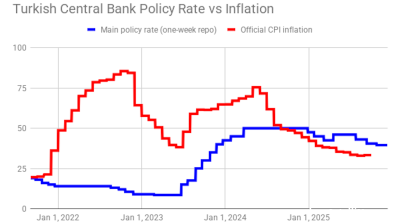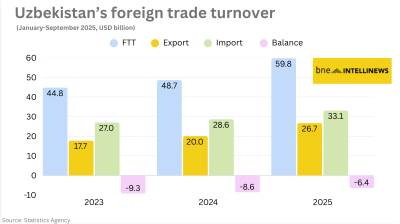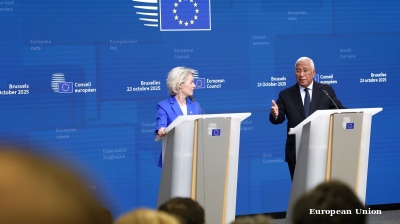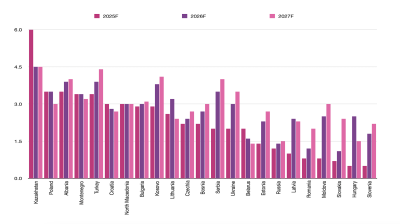Ukraine’s leading investment bank Dragon Capital has cut its GDP forecast for Ukraine in 2024 in half to 4% y/y in anticipation of another year of war, The New Voice of Ukraine reported on December 7. (chart)
The bank also forecast that the hryvnia exchange rate will fall to UAH39 to the dollar by the end of the next year as Ukraine’s finances come under increasing pressure thanks to falling financial support by the US.
"Given the dynamics of events on the front, we revise our key assumption for 2024, expecting that the war is likely to continue throughout next year," Dragon Capital’s chief economist Olena Bilan said in a note.
Ukraine’s outlook for 2024 remains up in the air and will depend heavily on both the events in the conflict and the amount of international support the country receives.
The International Monetary Fund (IMF) recently upped its growth forecast to reach 1-3% this year, 3.2% next year, and 6.5% in 2025. Concorde Capital, another leading Ukrainian investment bank, predicts 6% growth this year but no more than 3% after that. The European Commission also recently upped its outlook for this year to 4.8%, but reduced its 2024 projection from 4% to 3.7%, before growth rebounds in 2025 to 6.1%.
The continuation of the conflict means that Ukraine's economy may not benefit from the partial return of refugees and improved economic sentiment. Still, the resumption of exports through Ukraine's Black Sea ports has the potential to be a significant driver of economic growth.
Ukraine has successfully set up a temporary corridor for seaborne grain exports, a crucial source of foreign exchange earnings, that has been strangled after Black Sea Grain Initiative collapsed on July 17.
Dragon Capital estimates that at least 46 ships carrying a total cargo capacity of 1.85mn tonnes have entered Ukrainian Black Sea ports. The majority of these vessels arrived at the ports of Odesa in October, loaded with goods traditionally shipped by sea, including agricultural and industrial products.
Analysts believe that a full resumption of transportation through the Black Sea ports could increase export revenues by $9-10bn in 2024, resulting in a positive impact on real GDP growth of up to 5 percentage points. However, it could also lead to a rise in inflation due to secondary effects on domestic grain prices, potentially increasing it by an additional 2.5 percentage points, NV reports.
Despite the potential for economic growth, the ongoing hostilities pose a risk to ships sailing to Ukrainian ports in the Black Sea. Although Ukraine’s farmers brought in a bumper harvest this year, grain exports in recent months are down by a third and many agricultural enterprises are loss-making as a result.
Ukraine grew 6% of the world’s grain production in 2023, according to the Ukrainian Grain Association (UGA), or 81mn tonnes of grain.
"Ukraine is located on such soils that we depend on the weather more than technologies. Technologies in Ukraine have advanced over the past 20-30 years and helped to grow 100mn tonnes compared to 30mn tonnes a few decades back. This year, Ukrainian farmers were lucky with the weather, leading to the higher-than-average-yield for all crops. We harvested a record yield for each crop type," said the head of the Grain Association, reports UBN.
He said this allowed the country to compensate for losing 6mn hectares of arable land to war. At the same time, more than 2.5bn tonnes of grain are produced worldwide; Ukraine accounts for about 5-6% of the world's grain market. UGA hopes that the 2023-2024 marketing year will equalise global prices and that Ukrainian agricultural producers will not suffer losses.
Dragon Capital is also being cautious and does not expect a full recovery of shipping through the Black Sea ports. Based on export volume fluctuations and expectations of continued development in the domestic military sector, analysts forecast that Ukraine's real GDP will grow by 4% year on year in 2024, compared to its previously expected 8% in a scenario with reduced security risks.
Dragon Capital’s growth forecast for 2023 remains unchanged at 4.5% y/y, with economic activity stabilising in the third quarter of 2023.
Dragon Capital also anticipates that Ukraine's foreign partners will continue to provide financial support, consolidating $40bn in direct budget support through the IMF next year. This should help finance the budget deficit and contribute to further growth in NBU reserves to $45bn in 2024, allowing for the gradual easing of currency restrictions.
Ukrainian President Volodymyr Zelenskiy recently signed Ukraine’s 2024 budget into law that calls for $43bn in international aid, but with Ukraine’s funding in increasing doubt, the Ministry of Finance (MinFin) has already admitted that $29bn of that is still unaccounted for.
Ukraine is running out of money again and in the meantime the government has been working on a Plan B contingency plan that calls for spending cuts and ultimately turning on the printing presses if enough money cannot be scrapped together.
Regarding the exchange rate, Dragon Capital has adjusted its forecast, expecting the hryvnia to reach UAH37 per dollar by the end of this year and UAH39 per dollar by the end of 2024.
In terms of inflation, the firm lowered its forecast for the end of 2023 to 6.0% y/y due to a stronger-than-expected decline in fundamental pressures and increased forecasts for certain crop harvests. In 2024, inflation is expected to accelerate to 8.0%, primarily due to higher domestic agricultural prices resulting from the partial recovery of Black Sea ports.
Inflation will stay in the range of 6%-7% in 2024 at least until summer before picking up somewhat by the end of the year, according to ICU, another Ukrainian investment bank. The National Bank of Ukraine (NBU) monetary-policy easing cycle is almost done, after inflation fell back into single digits in the second half of this year, but symbolic cuts are possible in 2H24 if inflation and FX market risks remain balanced, says ICU.
Despite the adjustments, Dragon Capital acknowledges that the main risks to its forecast remain associated with the ongoing conflict, including the situation on the front and potential damage to critical infrastructure. Russia is widely expected to target Ukraine’s power and heating infrastructure this winter in the hopes of freezing Ukraine into submission.
Additionally, the volume and pace of foreign financing remain key risk factors for Ukraine's economy, with a significant decrease in financial assistance or delays in receiving funds potentially undermining macroeconomic stability.
Data

Turkey's central bank remains cautious, delivers 100bp rate cut
Decision comes on eve of next hearing in trial that could dislodge leadership of opposition CHP party.

Polish retail sales return to solid growth in September
Polish retail sales grew 6.4% year on year in constant prices in September, picking up from a 3.1% y/y rise in August, the statistics office GUS said.

Uzbekistan’s nine-month foreign trade nears $60bn
Export growth of 33% and import expansion of 16% y/y produce $6.4bn deficit.

Hungary’s central bank leaves rates unchanged
National Bank of Hungary expects inflation to fall back into the tolerance band by early 2026, with the 3% target sustainably achievable in early 2027 under the current strict policy settings.




